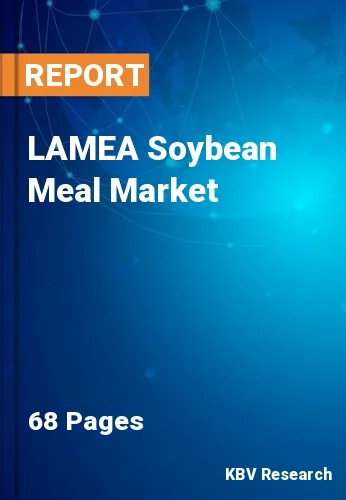The Latin America, Middle East and Africa Soybean Meal Market would witness market growth of 7.7% CAGR during the forecast period (2022-2028).
The soybean seeds go through a variety of processes that are designed to improve both the oil extraction process and the quality of the soybean meal. Cooking the seeds has a number of beneficial effects, including moisture conditioning of the seeds and ease in dehulling; a reduction in oil viscosity; an increase in the plasticity of the seed; the breaking of cell walls; protein clotting as a result of denaturation; sterilization; and the deactivation and destruction of thermosensitive enzymes and thermolabile antinutritional factors (ANFs).
The crushing and flaking processes change the permeability of the soybean flakes, which facilitates the next phase of the solvent extraction process. The oil-rich kernel is removed during the dehulling process, which is an optional step that separates the kernel from the hulls, which make up 8% of the seed and are mostly fibrous, and contain just a little amount of oil. The removal of the shell also eliminates antinutritional elements.
As a result of its one-of-a-kind amino acid profile, soybean meal is an excellent substitute for the proteins found in cereal grains. Meal made from soybeans is used in the production of both animal feed and nourishment for people. The rising population of livestock, ruminants, cattle, and other animals that are fed soybean meal is one of the primary factors contributing to the rising demand for soybean meal. Other reasons include the health benefits associated with this food, which is rich in protein, and the increasing population of people who eat it. The limits that have been put on slaughterhouse byproducts are the second factor that has contributed to the rise in demand. As a result of these restrictions, the market for soybean meal has grown. During the time period covered by the projection, it is anticipated that this would further stimulate growth in the market for soybean meals in LAMEA.
The Brazil market dominated the LAMEA Soybean Meal Market by Country in 2021, and would continue to be a dominant market till 2028; thereby, achieving a market value of $1,348.3 Million by 2028. The Argentina market is experiencing a CAGR of 8.2% during (2022 - 2028). Additionally, The UAE market would display a CAGR of 7.3% during (2022 - 2028).
Based on Distribution Channel, the market is segmented into Offline, Online, and B2B. Based on Nature, the market is segmented into Conventional, and Organic. Based on Application, the market is segmented into Animal Feed Industry, Food Industry, and Pharmaceutical. Based on countries, the market is segmented into Brazil, Argentina, UAE, Saudi Arabia, South Africa, Nigeria, and Rest of LAMEA.
Free Valuable Insights: The Global Soybean Meal Market is Predict to reach $78.2 Billion by 2028, at a CAGR of 5.1%
The market research report covers the analysis of key stake holders of the market. Key companies profiled in the report include Bunge Limited, Louis Dreyfus Company B.V., Kemin Industries, Inc., The Scoular Company, Mamta Hygiene Products Pvt. Ltd, Mahesh Agro Food Industries, Nordic Soya Ltd., Denofa AS (Amaggi Agropecuária), DHN International, and Minnesota Soybean Processors.
By Distribution Channel
By Nature
By Application
By Country
Our team of dedicated experts can provide you with attractive expansion opportunities for your business.

